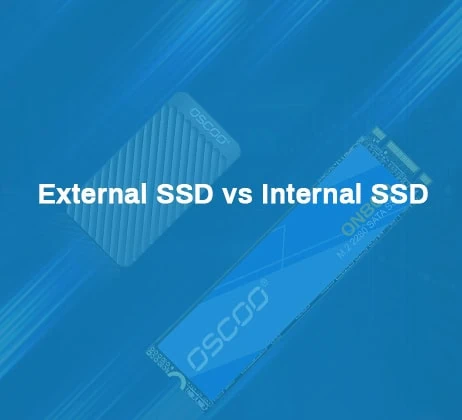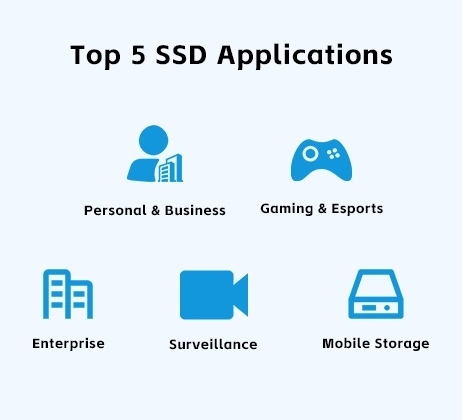Market Trends, Architecture Comparison & Performance-Cost Insights
As data centers and enterprise IT infrastructure increasingly move toward high performance, low latency, and distributed deployment, enterprise-grade SSDs have entered a pivotal stage of evolution in 2025. From legacy SATA interfaces to cutting-edge PCIe 5.0 NVMe protocols, enterprises now have a wide spectrum of SSD choices—each with distinct advantages in performance, endurance, compatibility, and cost.
This guide aims to help enterprise users understand 2025’s mainstream SSD technology trends, assess application-specific product suitability, and make smarter purchasing decisions based on performance-to-cost ratios.

Technology Evolution Overview
1. SATA SSD: A Stable & Cost-Efficient Choice
Although SATA III has reached its speed limit (~560MB/s), it still offers strong advantages in affordability, compatibility, and maturity. SATA SSDs remain widely used in light workloads, read-heavy environments, or mixed-use cases.
Advantages: Low cost, wide compatibility, ideal for legacy servers or embedded systems.
Limitations: Limited bandwidth, not suitable for high-concurrency data processing.
2. NVMe PCIe SSD: The Mainstream Performance Solution
Combining NVMe protocol with PCIe lanes brings SSDs into the high-performance era. Under PCIe 4.0 and 5.0, sequential read speeds can exceed 7,000MB/s (Gen4) and even 14,000MB/s (Gen5).
Main form factors:
U.2 (SFF-8639): Widely used in server racks; hot-swappable with robust power-loss protection.
M.2: Compact and fast, ideal for high-density or edge deployments (requires proper cooling).
E1.S / E3.S (EDSFF): Emerging enterprise form factors optimized for cooling and storage density; likely to replace U.2 in large-scale data centers.
Industry Trends & Deployment Drivers
1. Interface Upgrades Drive Architecture Refresh
With PCIe 5.0 becoming standard in server platforms, enterprises are adopting Gen5 SSDs for latency-sensitive applications such as AI acceleration, database caching, and high-frequency trading.
2. Tiered Storage Strategy Gains Momentum
Enterprises are increasingly separating workloads by performance tier—using NVMe SSDs for “hot data” (active processing) and SATA SSDs for “cold data” (archival or secondary storage)—to optimize Total Cost of Ownership (TCO).
3. Reliability & Data Protection in Focus
As write workloads intensify, key features like TBW (Total Bytes Written), MTBF (Mean Time Between Failures), PLP (Power Loss Protection), ECC (Error Correction Code), and AES encryption have become essential and are standard in enterprise SSDs by 2025.
III. Cross-Comparison of Mainstream Enterprise SSDs

From the table, it’s clear that SATA SSDs are still cost-effective for read-heavy or archival storage, while PCIe SSDs offer superior throughput, concurrency, and reliability for performance-driven environments.
Performance vs. Cost: Achieving Optimal TCO
Choosing enterprise SSDs is not just about peak speed or lowest price. Key considerations include:
TBW & DWPD: Critical for applications with heavy write cycles.
Power Efficiency: Affects long-term operational costs during 24/7 workloads.
Data Protection: PLP, LDPC, and SMART monitoring ensure system stability and data integrity.
Thermal Design: Inadequate cooling may lead to throttling and performance drops.
OSCOO’s Perspective: Advancing Enterprise Storage
As a global provider of advanced storage solutions, OSCOO continues to expand its enterprise SSD lineup, covering SATA, U.2, M.2 and more. We focus on:
- High-quality original NAND flash, optimized for long-term stability.
- Comprehensive protection features including PLP, ECC, and temperature control.
- Customizable interfaces and thermal designs for diverse enterprise environments.
- End-to-end technical support from selection to deployment.

Conclusion: A Strategic Approach to SSD Investment
In an era of accelerating digital transformation and AI-driven workloads, enterprise SSDs are no longer just components—they are strategic assets. Choosing the right SSD architecture in 2025 involves aligning technical specs with business goals, ensuring system resilience, and achieving long-term return on investment.
Let OSCOO be your trusted partner in building a smarter, faster, and more resilient data foundation.
For enterprise SSD consultation or tailored deployment solutions, please contact OSCOO.




